"Rules for Using Our Site" Clause in Terms & Conditions
Though having a Terms and Conditions agreement isn't legally required for your website, it can be helpful since it protects you from liability in the event that someone decides to sue you. For this reason alone it is recommended that your website have an airtight Terms and Conditions.
But beyond protecting yourself from potential litigation, it gives you reasonable permission to remove users from your platform or site if they are not behaving in accordance with your standards.
A Terms and Conditions agreement is essentially a contract between the website and the visitor. It introduces the service and asks the visitor to agree to the Terms and Conditions set forth in the document.
Introduction and Agreement
One essential part of a Terms and Conditions agreement is the agreement.
A Terms and Conditions agreement is often prefaced by an introduction and acceptance of the foregoing agreement. The introduction often tells the visitor that their use of the website is considered to be their acceptance of the Terms and Conditions agreement. This type of agreement is known as a browsewrap agreement.
Here's an example from PODS:

In the case of a browsewrap agreement, a hyperlink to the Terms and Conditions agreement is usually found at the bottom of the homepage. The usage of the site or service is considered to be an agreement to the Terms and Conditions agreement of the website.
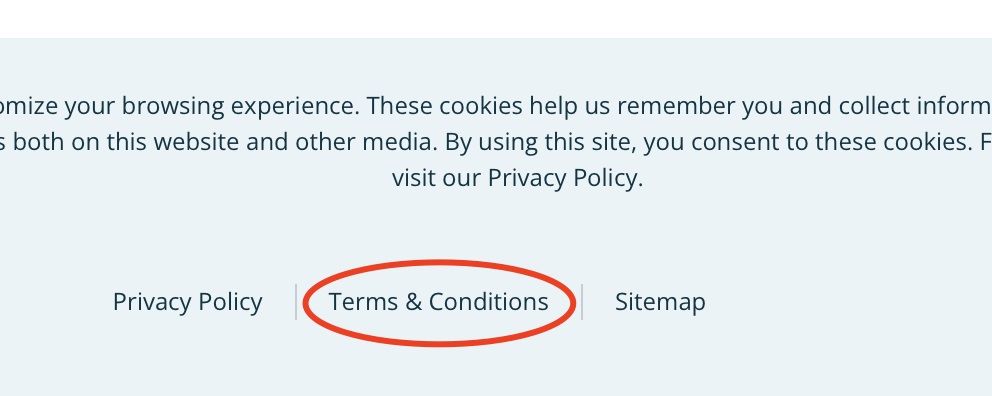
A clickwrap agreement is when the visitor is confronted with the terms and conditions before using the site or service. When clicking a button to register or sign in to a website, it will state that you are agreeing to the Terms and Conditions agreement by doing so.
Here's an example from MLB:
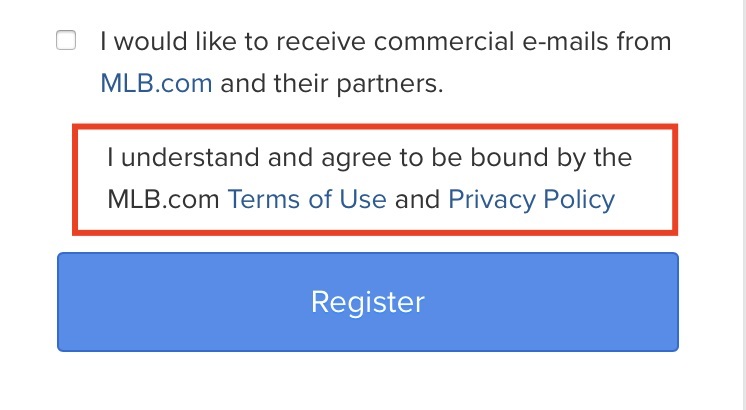
Alternatively, a website may ask users to actively accept the Terms and Conditions agreement by clicking a checkbox. The checkbox will usually state, "I agree to the terms and conditions."
Restrictions on Use
When a user accepts the Terms and Conditions agreement of a website, they are agreeing to abide by the rules of the platform.
A near essential requirement of a Terms and Conditions agreement is a clause or section outlining the rules for using the site or service. This section may be titled "Rules for Using our Site or Service" or "Restrictions on Use."
This lets the visitors of your website know their responsibilities when it comes to using the website. There is no uniform "Rules for Using our Site or Service" clause. Depending on the website and type of business, it may not need to include certain restrictions.
Some of the restrictions surround conduct and some are related to how the information found on the site may be used by the visitor. However, it generally includes the following rules or restrictions:
- No decompiling, disassembling, or reverse engineering
- No harassing, abusing, or intimidation toward other users
- No impersonation of other people/users
- No Transmission of information without consent
- Prohibition of copyright infringement
- The website/platform must be used in accordance with local governing laws
- The visitor must adhere to the privacy policy of the website
In addition, the website will usually uphold its right to make legal decisions in their sole discretion including but not limited to termination of user content and accounts.
Various Formats of Restriction Clauses
When reading through a Terms and Conditions agreement, the restrictions clause may not stand out right away. However, it is typically toward the beginning of the Terms and Conditions agreement document, usually shortly after the introduction.
This clause will also not be uniform in format across the board. Many are paragraph format, such as a large block of text that includes all of the restrictions. Among those in paragraph format, some explicitly label the beginning of this clause. PODS uses such a format:
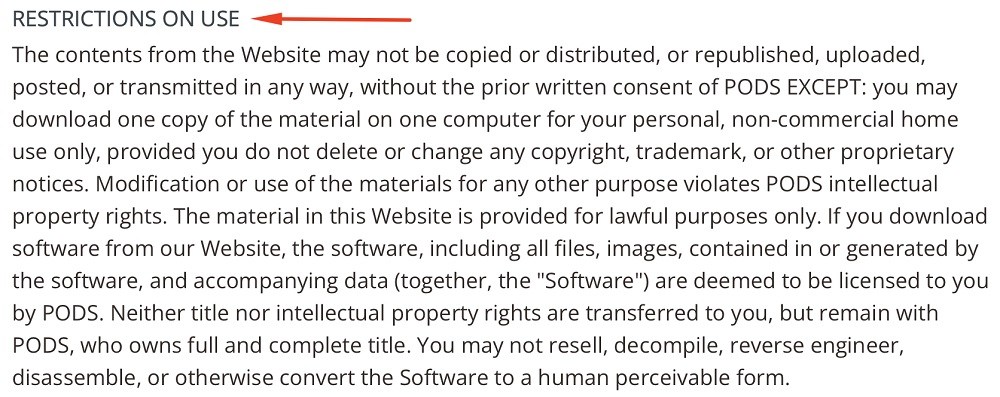
The section is titled "Restrictions on Use." It includes many of the above restrictions previously mentioned. In addition to restricting the activities of website visitors, it also grants them permission to download a copy of information found on the website as long as it is for non-commercial use. Everything obtained from the PODS website is considered on-loan or licensed by PODS to the user.
Another common way of formatting restriction clauses is by using bulleted lists. Wikimedia's section is clearly titled "Refraining from Certain Activities" followed by detailed and bulleted subheadings:
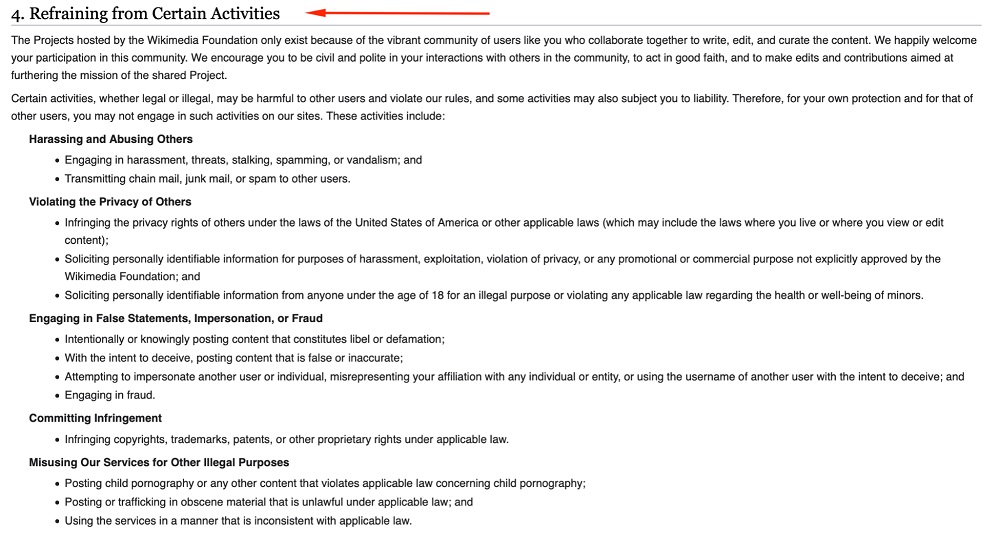
One of the obvious advantages to this format is that it clearly and succinctly describes the restrictions. It also has less potential to deter the reader from simply skimming over the Terms and Conditions agreement. More than just listing general restrictions which are found in the subheadings, the bulleted lists give examples of restricted activities.
For example, the subheading titled "Misusing Our Services for Other Illegal Purposes" states that posting obscene material that is unlawful is prohibited.
Another format that can be used is the paragraph format, but one that does not clearly delineate where the restrictions clause begins and ends.
MLB includes the restrictions clause in the first section of its Terms and Conditions agreement:

It introduces the section but it also includes things other than the restrictions, which here are called "Prohibitions." It isn't until the third paragraph of this section that there is mention of the prohibitions:

However, there are also other sections within the same Terms and Conditions agreement that give restrictions for users regarding copyright infringement and community features. So there are multiple clauses within this one Terms and Conditions agreement that give restrictions. However, the one in the introductory section may properly be called a restrictions clause.
Sometimes no single specific clause may be found. This is often the case with businesses whose brand extends beyond the website itself.
For example, Amazon's brand is found in the marketplace with Amazon Fresh, Kindle, and more. The Terms and Conditions agreement does not include one specific restriction clause. Since Amazon offers such a wide variety of services, the Terms and Conditions agreement for each service will apply individually.
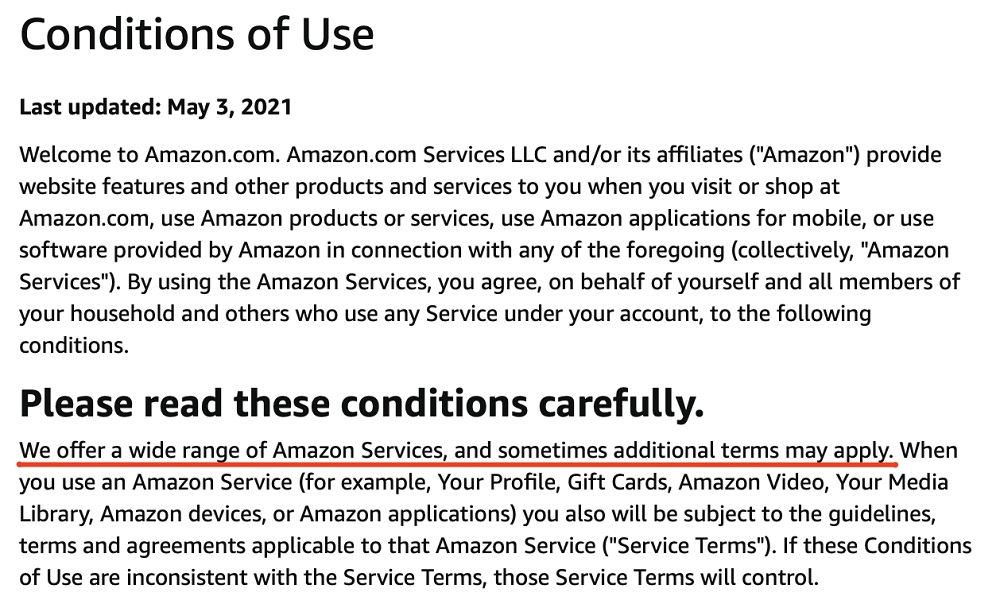
The material included in the above linked Terms and Conditions agreement is general and applicable to all Amazon services but is by no means comprehensive since it states "... you will also be subject to the guidelines, terms and agreements applicable to that Amazon Service."
In general, you can expect a restriction clause to be found toward the beginning of a Terms and Conditions agreement. It will be either a designated paragraph or section, a bulleted list, or the clauses may be found throughout the entire Terms and Conditions agreement. But in reality there is no one size fits all rule when it comes to a restrictions clause. Many are completely unique.
External Software or Device Usage in Restrictions Clauses
Some companies utilize external software or apps for mobile devices. There are also restrictions governing the usage of these apps. In the same Terms and Conditions agreement from Amazon, there is a numbered list.
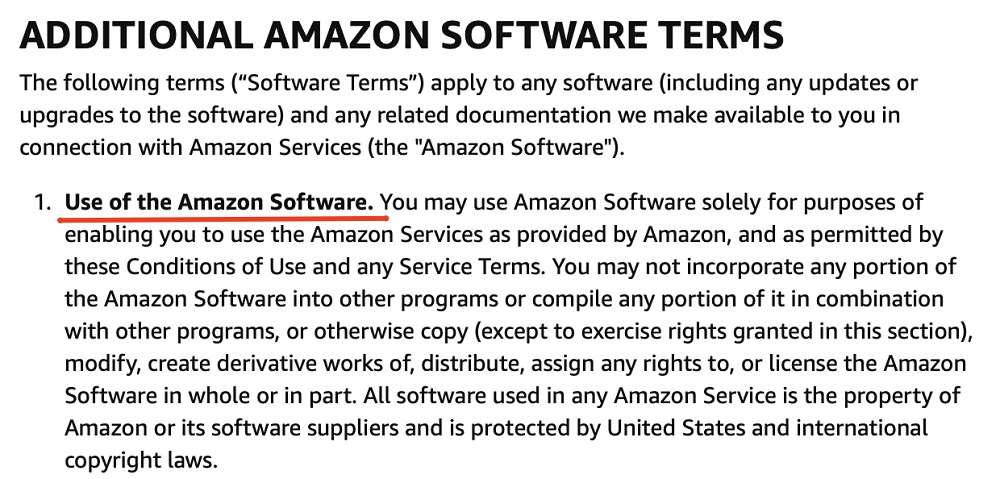
This tells the user that they are only allowed to use the software, on any device, in accordance with Amazon Services. That is, it should only be used for what it is designed for. A clause further down the list states that no reverse engineering is allowed.
Terminology Found in Restrictions Clauses
Here are some terms with their definitions that might prove helpful when reading a Terms and Conditions agreement.
- Reverse engineering - The breaking down of various components of the website's platform to figure out how it was built.
- Compiling - The conversion of source code into binary code that a computer can read. This, reverse engineering, and other programming related processes are restricted to discourage tampering with the website or associated platforms.
- Copyright infringement - The personal appropriation of a company's intellectual property, branding, etc. without their express written permission.
Keep in mind that not every website will use the same exact terms for the same type of restriction.
Conclusion
When it comes to adding a "Rules for Using Our Site or Service Clause" on your website, at the bare minimum you need to ensure that you protect your intellectual property, by prohibiting unlawful and unlicensed transmission of and tampering with the information found in your website.
You also need to reserve the right to remove users at any time from your platform who do not abide by your rules.
In general, the more restrictions you have (within reason), the more protected you will be. You would do well to not skimp on this section of your Terms and Conditions agreement.